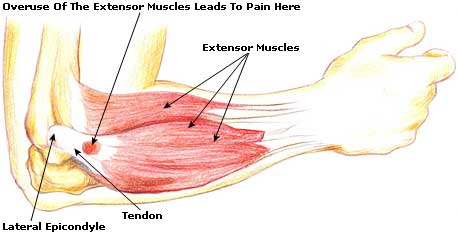The Latest and Greatest in the Treatment and Management of Tennis Elbow
The Latest and Greatest in the Treatment and Management of Tennis Elbow
Tennis Elbow is a condition that has baffled researchers and health professional for a number of years. While it can be easy to diagnose it is a difficult condition to manage and can often take six months to two years to fully resolve.
What is Tennis Elbow?
Let us start with a bit of background around Tennis Elbow. Tennis elbow or Lateral Epicondylitis/ Lateral elbow tendinopathy is a pathology involving the tendons in the forearm that attach to a bony prominence known as the lateral epicondyle.

This condition affects 1-3% of the population and is more prevalent in the working population with 15% of workers suffering this injury during their working life. Tennis elbow often begins after a minor trauma to the elbow. People suffering this condition will report pain and tenderness over the outside of the elbow, stiffness and or weakness with tasks involving the arms and elbow.
Tennis elbow affects 1-3% of the population & 15% of workers during their working life #tenniselbow #physio Share on X
Recent research has demonstrated that there is NO inflammatory process associated with tennis elbow. Rather there is an associated increase in nerve transmission chemicals, blood supply and derangement/degeneration of the cells that make up the tendon called tenocytes.
Recent research has demonstrated that there is NO inflammatory process associated with #tenniselbow #mythbusters #physio Share on X
Recent research
A recent study headed up by Leanne Bisset in 2006 looked at the difference in outcomes at 52 weeks between physiotherapy, ‘wait and see’, and cortico-steroid injection for the treatment of Tennis Elbow. This was a beautiful and well controlled study with 198 participants.
Results of the study concluded that cortico-steroid injection was the fastest at reducing pain in the first 6 weeks but had the highest rate of re occurrence out of all three groups. In fact 47/65 of the successful cases at 6 weeks regressed and cortisone was shown to have poorer outcomes long term than both wait and see and physiotherapy. This then raised questions as to the influence of these injections long term for the health of the tendon.
See HERE for a previous blog post about tennis elbow tendon treatment with PRP injections.
Physiotherapy at the 6 week mark was better than ‘wait and see’ for pain and function however both had the same long term outcome at 52 weeks. The ‘wait and see’ group were educated about their pathology and given advice on medication and braces and how to avoid overloading the tendon. The physiotherapy group were given the same advice and then 8 sessions of physiotherapy over 6 weeks consisting of joint manipulation and exercise.
The take away points of this study:
- with sound load management 80% of tennis elbow cases will make a full recovery at 52 weeks
- but with physiotherapy intervention people will get out of pain faster and experience less pain over the duration of their recovery.
#tenniselbow sufferers will get out of pain faster & experience less pain over the duration of their recovery with #physio Share on X
Leanne Bisset performed another study in 2011 which compiled the results of hundreds of other studies on Tennis elbow and evaluating various interventions.
Tennis Elbow Treatment Review
Cortisone Injections
Cortisone has been proven to be the best at reducing pain and improving function in the short term (6 weeks). It is possible however that a single cortisone injection may lead to an increased rate or recurrence or that repeated cortisone injection will increase the risk of surgery. Applying non steroidal anti- inflammatory drugs to the area has been proven to help with pain in the short term however little is known about the long term effects of this treatment option.
Cortisone 4 #tenniselbow may lead to an increased rate or recurrence & an increased risk of surgery, but it does offer effective short term relief #physio Share on X
Other Treatment Options
The results of the remaining list of treatment options were inconclusive/no more beneficial than placebo, or there was a lack of strong evidence or good quality trials. These modalities included
- Extra-corporeal Shock Wave Therapy
- Orthoses or braces
- Acupuncture
- Manipulation
- Exercise and mobilisation
- open or percutaneous surgical techniques
- combination physical therapies
- ultrasound
- iontophoresis
- pulsed electromagnetic field treatment
- Low-level laser therapy may be beneficial at improving pain in the short term when compared with placebo.
Making sense of it all
So what would you do if you got tennis elbow next week? The most important thing to do when any tendon in the body becomes sore is to modify or reduce the load going through the tendon. This means adjusting what you are doing through-out the day to rest the tendon a little.
The most important thing to do when a tendon becomes sore is 2 modify or reduce the load going through the tendon #physio #tendon Share on X
Examples of ways to reduce the load through your elbow tendons include:
- using your other hand
- wearing a brace which disperses load from the tendon onto surrounding tissue
- avoiding where possible certain loads such as skipping a game of golf
- using more machines at work rather than man power
- changing the height of your work station
- trying to avoid repetitive tasks
It is important that this load is modified for the duration of the tendinopathy (or tendon injury). As the tendon heals it will be able to cope with more load and you will be able to do more things without pain. It is also important to note that tendons do not like being completely rested. An example of this would be someone who rested their elbow for 12 weeks and when returning to activity noticed that they still had pain.
Specific tendon loading exercise has been shown to have good outcomes in the long term. These exercises will be specifically prescribed to you by your physiotherapist and will get progressively harder as the tendon heals. It is very important that these exercises are pain free.
The Unfortunate Few
There is a sub-group of people suffering tennis elbow who will not recover in 1 year. This group makes up 20% of sufferers and sufferers are characterised by higher levels of pain and who have a greater level of disability. Predicting if someone is going to fall into this group is difficult.
One simple test that can be carried out in a treatment room is poking the area repeatedly with a small object. In normal participants this will not increase pain but in this particular subgroup it will. In this sub-group medication is more likely going to be necessary and exercise is likely going to be less effective.
Lindsay Young
Physiotherapist
References
1. Bisset, L., & Coombes, B. (2011). Tennis elbow. Clinical evidence, 2011.
2. http://www.ncbi.nlm.nih.gov/pmc/articles/PMC3217754/
3. Bisset, L., Beller, E., Jull, G., Brooks, P., Darnell, R., & Vicenzino, B. (2006). Mobilisation with movement and exercise, corticosteroid injection, or wait and see for tennis elbow: randomised trial. Bmj, 333(7575), 939.
4. Bisset, L., Smidt, N., Van der Windt, D. A., Bouter, L. M., Jull, G., Brooks, P., & Vicenzino, B. (2007). Conservative treatments for tennis elbow—do subgroups of patients respond differently?. Rheumatology, 46(10), 1601-1605.
5. du Toit, C., Stieler, M., Saunders, R., Bisset, L., & Vicenzino, B. (2008). Diagnostic accuracy of power Doppler ultrasound in patients with chronic tennis elbow. British journal of sports medicine, 42(11), 872-876.
6. Nirschl, R. P. (1992). Elbow tendinosis/tennis elbow. Clinics in sports medicine, 11(4), 851-870.










Happy healthy 2016 Brad! Trust the new year will bring you prosperity and continued success!
I found your article on Tennis Elbow, particularly the exercise trailer very informative and helpful as I too suffer with this condition due to overuse.
Must come into Pogo soon Brad for a treatment when you have availability.
Kind regards
Sue Vida
Hi Sue,
Great to hear from you. I’m pleased you found the article helpful.
Brad Beer
POGO Physio